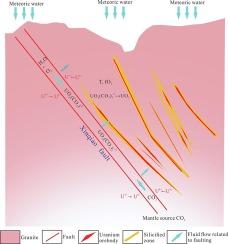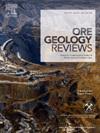Unraveling the metallogenic mechanisms of uranium-rich ore bodies: Insights from Xinqiaoxi’s pitchblende geochronology and pyrite geochemistry
IF 3.2
2区 地球科学
Q1 GEOLOGY
引用次数: 0
Abstract
Granite-related uranium deposits are essential for the global uranium supply, with the uranium-rich ore bodies within these deposits being crucial to their value. However, the sources of uranium, fluid characteristics, and metallogenic mechanisms within these uranium-rich ore bodies remain unclear. In this study, we analyzed pitchblende and pyrite from the Xinqiaoxi uranium deposit to determine uranium age and clarify the mineralization of uranium-rich ore bodies. The pitchblende samples provided a U-Pb age of 58.5 ± 3 Ma (MSWD = 3.4), closely aligns with the mineralization ages in other uranium deposits within the Xiazhuang uranium ore-field. This consistency suggests a significant uranium mineralization event in South China during this period. The vein-like and concentric structure of the pitchblende, coupled with its enrichment in U, Sr, As, W, and Mo but depletion in Th, Pb, and REEs, indicates a strong association with hydrothermal activity. Moreover, its REE pattern closely resembles that of the host rock (Xiazhuang and Maofeng granites), suggesting the latter as a crucial uranium source. Pyrite and pitchblende are coeval, yet pyrite was formed slightly earlier than pitchblende. Pyrite exhibits depletion in Co and Ni but enrichment in As, along with high Co/Ni ratios ranging from 1.68 to 12.2, indicative of a medium- to low temperature hydrothermal genesis. Furthermore, the positive cerium (Ce) anomaly observed in pyrite may indicate elevated oxygen fugacity in the fluids during precipitation. The δ34S values of pyrite (−10.42 ‰ to −15.26 ‰, averaging −13.44 ‰) are consistent with those of the host rock (Xiazhuang and Maofeng granites), indicating a primary sulfur source from the host rock. Additionally, pyrite may serve as a reductant, facilitating the formation of uranium ore. Our proposed genetic model suggests that CO2-rich oxidizing fluids facilitate uranium leaching from host rocks, resulting in the formation of a uranium-enriched fluid that migrates along faults, where U6+ undergoes reduction to U4+ within secondary fracture zones, facilitated by reductants such as pyrite.

揭示富铀矿体的成矿机制:新桥溪黝帘石地质年代和黄铁矿地球化学的启示
与花岗岩有关的铀矿床对全球铀供应至关重要,而这些矿床中的富铀矿体对其价值至关重要。然而,这些富铀矿体中的铀来源、流体特征和成矿机制仍不清楚。在这项研究中,我们分析了新桥溪铀矿床中的黝帘石和黄铁矿,以确定铀的年龄并明确富铀矿体的成矿机制。黝帘石样品的U-Pb年龄为58.5 ± 3 Ma (MSWD = 3.4),与夏庄铀矿区内其他铀矿床的成矿年龄密切相关。这种一致性表明,在这一时期,华南地区发生了一次重要的铀矿化事件。黝帘石的脉状和同心圆结构,加上其铀、锶、砷、钨和钼的富集,而钍、铅和稀土元素的贫化,表明其与热液活动密切相关。此外,其 REE 模式与主岩(夏庄花岗岩和毛峰花岗岩)非常相似,表明后者是重要的铀源。黄铁矿和黝帘石是共生的,但黄铁矿的形成略早于黝帘石。黄铁矿的钴和镍含量较低,但砷含量较高,钴镍比从 1.68 到 12.2 不等,表明黄铁矿是中低温热液成因。此外,在黄铁矿中观察到的正铈(Ce)异常可能表明在沉淀过程中流体中的氧富集度升高。黄铁矿的δ34S值(-10.42‰至-15.26‰,平均-13.44‰)与主岩(夏庄花岗岩和毛峰花岗岩)的δ34S值一致,表明硫主要来源于主岩。此外,黄铁矿还可作为还原剂,促进铀矿的形成。我们提出的成因模型表明,富含二氧化碳的氧化流体促进了主岩中铀的沥滤,从而形成富含铀的流体,该流体沿断层迁移,在黄铁矿等还原剂的作用下,U6+在次生断裂带内还原成U4+。
本文章由计算机程序翻译,如有差异,请以英文原文为准。
求助全文
约1分钟内获得全文
求助全文
来源期刊

Ore Geology Reviews
地学-地质学
CiteScore
6.50
自引率
27.30%
发文量
546
审稿时长
22.9 weeks
期刊介绍:
Ore Geology Reviews aims to familiarize all earth scientists with recent advances in a number of interconnected disciplines related to the study of, and search for, ore deposits. The reviews range from brief to longer contributions, but the journal preferentially publishes manuscripts that fill the niche between the commonly shorter journal articles and the comprehensive book coverages, and thus has a special appeal to many authors and readers.
 求助内容:
求助内容: 应助结果提醒方式:
应助结果提醒方式:


